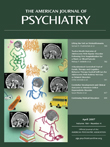Introductory Textbook of Psychiatry, Fourth Edition
It is reassuring when books or people fulfill their promise. Introductory Textbook of Psychiatry, Fourth Edition , by Nancy C. Andreasen, M.D., Ph.D., and Donald W. Black, M.D., continues its useful tradition of clarity, thoughtfulness, brevity, and reasonable width, depth, and balance. It will serve medical and other students well.
In this era of textbooks with dozens of chapters written by countless authors, it is also somewhat refreshing and pleasantly coherent to have an entire book written by two authors. That one author is herself both a leading biopsychiatric researcher and a distinguished former editor of The American Journal of Psychiatry adds solidity and authority to this well-integrated enterprise.
In addition to predictable major topics and organization, largely but not exclusively structured by DSM-IV categories, the book has some humor and humanity in its wide-ranging and sometimes provocative aphorisms before each chapter. It has a 35-page glossary, smart self-study questions, and a welcome 32-page bibliography. I would have wished the bibliography to be even longer and more annotated, and—one minor quibble—I might have preferred that it avoid some internal repetition, such as giving the full reference for DSM-IV 13 times.
After a sensible preface and introduction, the authors give us a chapter on Diagnosis and Classification and one on Interviewing and Assessment. These are followed by a timely chapter on the Neurobiology and Genetics of Mental Illness, of which the focus may be taken for granted by some medical students and researchers (but may usefully reshape some psychiatrists trained more than 10 years ago). The authors then go on to the main body of the book, eleven chapters on the major psychiatric disorders, largely structured by DSM-IV: Delirium, Dementia, and Amnestic Disorders; Schizophrenia and Other Psychotic Disorders; Mood Disorders; Anxiety Disorders; Somatoform, Dissociative, and Related Disorders; Alcohol and Drug-Related Disorders; Personality Disorders; Sexual Dysfunction, Paraphilias, and Gender Identity Disorders; Eating Disorders; Adjustment Disorders; and Impulse-Control Disorders.
The book concludes, usefully, with some additional chapters not well subsumed under the DSM-IV structure: Psychiatric Emergencies, Child Psychiatry, Sleep Disorders, Legal Issues, Psychological Treatments, and Psychopharmacology and Electroconvulsive Therapy.
The book covers the field well, yet no relatively short textbook can cover all bases in a way that will seem balanced to all interested readers. One hesitates to make any suggestions for the fifth edition, even within the context of high respect for the generally good balance of the book. Here are a few comments and suggestions anyway: a) the book seems to me too comfortable with the reality and adequacy of DSM-IV; b) the book is enthusiastic and particularly well-informed about the biological parts of the biopsychosocial whole of psychiatry and less enthusiastic and generous about the psychological and social parts; c) some areas might do well with a bit more space and emphasis, e.g., the history of psychiatry, biopsychosocial integration, psychodynamics, children, adolescents, families, development, play, work, relationships with others, trauma, protective factors, prevention, ethics, confidentiality, mild to moderate (and very common and costly) disorders, stigma, sociocultural issues, interactions with neurology, medicine, psychology, education, law, economics, politics, the community, and international public health.
The Introductory Textbook of Psychiatry, Fourth Edition covers much excellent material. It is an admirable, efficiently packed, clear, and timely introduction to 21st-century psychiatry.



